

| Insects | ||
| Eakring insects - record year in 2003 | ||
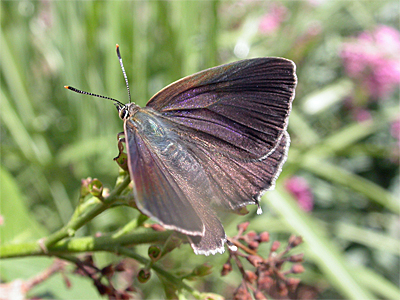 |
With the area
experiencing it's driest year since the hot Summer of
1976, the Summer of 2003 assisted the area's insects
towards an exceptional breeding season. The dry and often sunny weather the year will be remembered for, actually began as early as February and continued throughout the year until the end of the flight season around mid-October. Such a prolonged period of fine weather also allowed species such as the Wall Brown and Small Copper to produce third and fourth broods into early October. Regular periods of anti-cyclonic weather also saw the UK draw in southerly winds. These brought with them large numbers of migrant butterflies and moths into the southern-half of the country, the result of which the area was to witness later in the year as these early arrivals bred and produced subsequent adults. |
|
| .... | ||
| It was not
all about butterflies and moths though. In addition there
were increased numbers of dragonflies at certain sites.
Although the higher numbers present were much to do with
a fine and dry flight season, some species such as the
recent colonising Ruddy Darter and Large Red Damselfly,
were recorded in higher numbers during 2003 as a direct
result of reinforcing their respective (and previously
fragile) resident populations. Both also extended their
range here to either Eakring Meadows or Eakring Flash,
but with the hot sunny weather drying up all still water
sites with the exception of the latter by August, these
two species may have lost some ground in their continuing
spread throughout the area for a couple of years. Eakring Flash once again saw the largest numbers of both adults and species on the wing, by the end of October all 15 regular species had been recorded. This made 2003 the first year that all the area's Odonata species had been present, although both Four-spotted Chaser and Broad-bodied Chaser still remain rare here. |
||
| .... | ||
| The Odonata flight
season began on May 15th with the first Common Blue
Damselfly and continued into November with late Migrant
Hawkers and Common Darters. Of the smaller species (the
damselflies) most were easily described as being abundant
and a minimum count of 1000 Common Blue Damselfies were
at Eakring Flash on June 29th. The Blue-tailed Damselfly
was another of the most regularly found smaller species. The Azure Damselfly was found in good numbers for the first time around the small ponds at Eakring Meadows, then in increased numbers at Eakring Flash. 2003 certainly represented the most successful year to date for the Azure Damselfly, when only single adults were positively identified during previous years. The larger dragonflies were again much in evidence throughout the Summer. At least four adult Emperor Dragonflies were present at Eakring Flash (a count which included two ovipositing females) and Southern Hawkers were also much commoner than previously. |
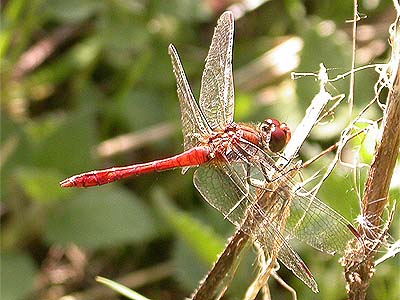 |
|
| .... | ||
| Southern
Hawkers are less tied to areas of water than most and are
the most likely large dragonfly to be found along
hedgerows or woodland edges. Black-tailed Skimmers
enjoyed continued success at Eakring Flash, where at
least 12 males patrolled the water in typical fashion. Enjoying an all year round flight-season, moths are always in evidence throughout the area - even on some of the coldest evenings. Though species' variety is small during the first months of the year, the potential is there through lack of previous recording and identification, to add new species to the area list. This potential was realised with an exerted effort and most favourable nights saw visits to the area. The resulting effect was that the moth list swelled considerably by both use of a portable camping light and permission to trap within Lound Wood and Hare Hill Wood throughout much of the year. By the end of 2003, this list stood at just over 250 identified species of moth, but this is believed to be just about 50% of the total species that the Eakring and Kersall area actually holds. An array of techniques were employed to attract/find or trap moths - all equally as productive. Among those recorded during the year were some notable moths. Although not always inspiring to look at, some new moths found this year attain as rare a status here as within Nottinghamshire as a whole. Perhaps the two most exciting new species were Marsh Pug and Phlyctaenia perlucidalis, despite both having rather drab appearences. The Marsh Pug was first found in an area of established meadowland on Red Hill (late May) before also being found at several sites in the Eakring Meadows Nature Reserve complex, then later at Oil Bore Holes in Eakring village. Most of the adults recorded were females, typically flying low within grasses searching for the flowers of Field Mouse-ear (Cerastium arvense) where eggs were noted being laid inside the flower heads. The Marsh Pug is currently ascribed a Grade 2 listing and it's small size renders it quite inconspicuous. The only other known site in Nottinghamshire is the Carr-lands around Misterton in the very north of the county. Subsequently, the occurrence of Marsh Pug represents a very important find. |
||
| .... | ||
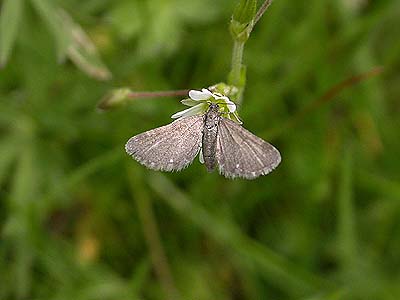 |
Phlyctaenia
perlucidalis was first recorded in Nottinghamshire
from Newstead Abbey in 1991. There have been a few more
recent records during the interim period, but the record
here still remains an extremely significant one. Migrant moths were represented by Diamond-back Moth, Silver Y and the spectacular Hummingbird Hawk-moth, which appeared in the area for the second time since 1998. With record numbers invading the UK, hopes were high that it would again be recorded and during the latter part of the Summer it was. Daily checking of patches of Valerian paid dividends and eventually, a succession of records occurred in September, following the first on August 23rd and peaking with three adults in Eakring village on September 15th. Records also came on 8th and 16-19th. There was a clear migration of Hummingbird Hawk-moths through the area during that period, but the Silver Y moth moved through in far greater numbers at the end of August. Many hundreds (and probably thousands) of adults were noted during this time. |
|
| The much
smaller Diamond-back Moth arrived in such substantial
numbers around mid-June, as to give it "very
common" status after an early migrant was netted
along the Kneesall Road on the early date of April 15th.
There were few records later in the year, which was
surprising after such a Spring influx. With the weather so favourable this year, most species produced much earlier emergences than in 2002. In some cases this was by as much as a month. There were also some partial second broods by certain species. A drive along the area's roads was again often the best way to see how populations were distributed, or where colonies were strongest. Because of habitat destruction, there are some moths whose distribution over the area is now more limited than say 20-30 years ago, but many grass-feeding species are still abundant along roadsides. Of the commoner moths found here, The Snout, Silver-ground Carpet and Mother of Pearl were all abundant again and featured heavily on trapping nights. |
||
| .... | ||
| Light-trapping certainly
proved to be the most reliable way of catching moths and
nocturnal sojourns provided further Grade 3 species
including Map-winged Swift, Small Elephant Hawk-moth,
Lunar Marbled Brown, Rufous Minor and Small Yellow
Underwing. The record of Small Elephant Hawk-moth was a real surprise, as agricultural farmland is hardly renowned as providing ideal habitat for the species, thus making it one of the most exciting moths of the year. The fact that so many graded county species were attracted to simple light-trapping techniques, shows just what valuable results can still be achieved in an age when many suppose such results are already known. Moth-trapping/recording is important, as much of the county has been little covered over the years and little is still actually known about the population or distribution of some of our resident moths. This work is obviously set to continue over the coming years. |
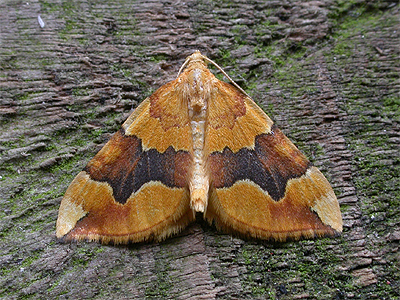 |
|
| The table below lists the total moths trapped/per species during the course of the year. Photographs of all species can be accessed via the insect photo gallery page. | ||
|
. |
|
||||||||||||||||||||||||||||||||||||||||||||||||||||||||||||||||||||||||||||||||||||||||||||||||||||||||||||||||||||||||||||||||||||||||||||||||||||||||||||||||||||||||||||||||||||||||||||||||||||||||||||||||||||||||||||||||||||||||||||||||||||||||||||||||||||||||||||||||||||||||||
| Butterflies
are many peoples prefferred choice of study. They are
active during the daytime and their study can be
adequately conducted during more sociable hours than are
offered by moths. 2003 was a special year year for the area's butterflies. Migrant butterflies poured through the area in exceptional numbers during the first week of August - the Brown Argus was re-discovered again for the first time since 2000 and new species for the area were the Purple Hairstreak and Essex Skipper - both found within July. Only one butterfly (the Holly Blue) struggled through parasitism. Holly Blue numbers were so low, that there were just single records of adults during each of the two broods. Such a low number of sightings is common every two or three years, when Holly Blue populations reach their lowest. All other species fared much better and as mentioned at the top of this review, were able to produce third and probably fourth broods in some cases through frequently hot and sunny weather. At the start of the year, a mild and sunny February and March allowed hibernating butterflies the chance to appear early. Nymphalids such as Peacock, Comma and Small Tortoiseshell bred early and certainly the latter named, produced a minimum of three broods. Larvae were so common around Nettles, that almost complete defoliation of Nettle-beds occurred and numbers were well into thousands at sites like Eakring Flash. A male Orange Tip on April 15th was very early, the following mornings seeing emergences of all the whites. By April 23rd, a Red Admiral was already ovipositing in Lound Wood on what was a new earliest date for the species. Painted Ladies appeared on May 24th, when three were present at Red Hill. Painted Ladies certainly arrived in much greater numbers and over a much shorter period than Red Admirals. By early August the second brood of adults had emerged and huge numbers were counted moving south-west on August 3rd. The event was a surprise (especially the scale of it) and the fact that it took place much earlier than I had anticipated any movement as being likely. Much smaller movements continued throughout August and into September, but the Painted Lady/Red Admiral ratio changed quickly over that period. |
||
| .... | ||
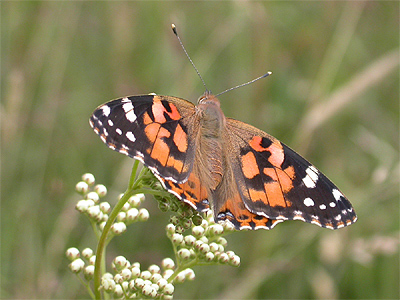 |
When Painted Lady counts
were scaled up for the entire width of the recording area
between it's widest points; then it is likely that with
recorders stationed at 200 metre intervals, they would
have recorded well in excess of 12,500 Painted Ladies.
Quite a staggering figure, yet most likely a minimum one
for the five hour period. The same rule applied to all
eight species, would have been 23,000. Following the good Red Admiral passage of September 30th 2000, when 82 moved through the Red Hill area; the move to the same vantage point soon reaped the rewards of witnessing a constant stream of loose groups of butterflies, heading low over the cereal fields south-west. Most were Painted Ladies, but a real surprise was that this movement incorporated seven additional species, most not noted for their migrating tendencies. Biggest surprise was the total of 106 Peacock and 47 Small Tortoiseshell, all following the same direction as the primary movers - 716 Painted Lady, 179 Large White and 134 Red Admiral. In all, a total of 1,281 butterflies of eight species moved through in 5 hours. The table produced below, shows the accumulated totals from the two vantage points used during the morning of August 3rd. |
|
| Date 03/08/03 | --- Eakring Flash --- | -------------------------- Red Hill ------------------------- | Total | ||
| Species | 10:30am-11:00am | 11:10am-13:10pm | 13:10pm-14:40pm | 14:40pm-15:40pm | |
| Painted Lady | 14 | 339 | 254 | 99 | 716 |
| Large White | 2 | 68 | 102 | 9 | 179 |
| Red Admiral | 2 | 50 | 75 | 9 | 134 |
| Peacock | . | 40 | 60 | 6 | 106 |
| Small White | 5 | 20 | 30 | 4 | 54 |
| Small Tortoiseshell | . | 16 | 24 | 7 | 47 |
| Green-veined White | . | 16 | 24 | 2 | 42 |
| Comma | . | 1 | 1 | 1 | 3 |
| Final counts
for the August 3-6th three day period are listed in the
table below right. Whilst both Large White, Red Admiral
and Painted Lady are well known migrants, the others are
not. I have still to come across any evidence that Peacock and Small Tortoiseshell have been recorded moving in such numbers before. The whole event and the species associated with it, was real enough, but seems to have been missed by most. It was also a widespread event and a phone call revealed that Painted Ladies were moving south-west through Rutland Water, at the same rate as they were here. |
||||||||||||||||||
| .... | ||||||||||||||||||
| Whilst this was an
exciting event to witness - others (equally exciting)
were the discovery of a Purple Hairstreak colony in Lound
Wood and the Essex Skipper at a green lane site, just
south-west of Eakring village. The Purple Hairstreak was the most likely species awaiting discovery. Yet after five years searching, had still not been found. The search finally ended in July, when a well populated colony was found on the edge of Lound Wood. |
|
|||||||||||||||||
| .... | ||||||||||||||||||
| One of the
reasons why this colony had been overlooked, was that the
adults were in the habit of feeding on sweet substances
found around the buds of adjacent Ash trees (Fraxinus
excelsior) This habit is also adopted by
White-letter Hairstreak adults in Hare Hill Wood, where
that species continues to do well. The Purple
Hairstreak's habit of frequenting the tops of mature
trees, makes recording this butterfly even more
difficult. The Essex Skipper was then found just a few days later at the end of July. This chance discovery of a species that had been tentatively looked for in the past, came whilst photographing Small Skippers and noticing the black underside of the antennae, which helps distinguish the Essex Skipper from the very similar Small Skipper. Since it's first appearance at Colwick Country Park in 1995 - the Essex Skipper continued it's northward range expansion through south-eastern Nottinghamshire during the late 1990's. By 1998, several sites as far north as Cotham, had recorded their first examples, whilst Colwick and Holme Pierrepont both continued to report the species on an almost annual basis. Like the Brown Argus, the Essex Skipper's rise as a colonist, has come at more or less the same time. Then again, many other butterflies (which were once a very difficult find in Nottinghamshire) have also continued to spread at a terrific rate. |
||||||||||||||||||
| .... | ||||||||||||||||||
| The pleasing theme
continued with the Small Skipper fighting back towards
it's former numbers of 1998, after the crash in numbers
the following year. The Speckled Wood, Ringlet and Wall
Brown were all widespread and commoner this year. The same green lane where the Essex Skipper was discovered, also provided the first sighting of the Brown Argus since 2000. This species was actively looked for last year, but was never found at it's previously known sites. This however, was a new site and then more diligent searching revealed that butterflies were again to be found in one small area of Eakring Meadows. The area's Brown Argus population is still severely threatened and is possibly the most likely to be lost to any development or agricultural mis-practice. Finally. Of interest was the discovery of a Hornet's nest in Lound Wood. This was the first documented record of this scarce wasp in the area. |
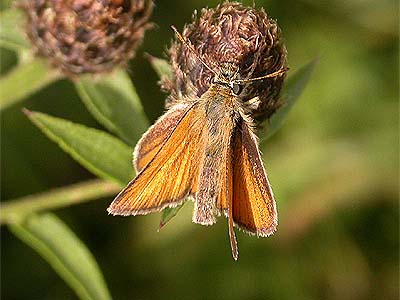 |
|||||||||||||||||